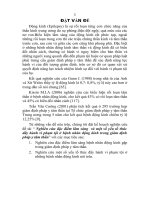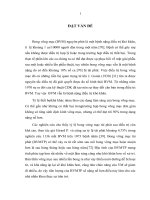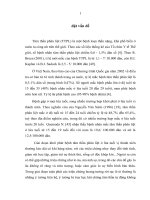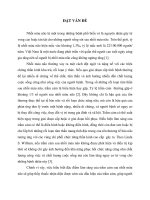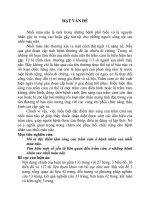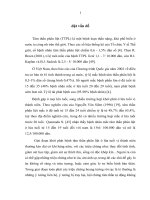Nghiên cứu đặc điểm lâm sàng và một số yếu tố liên quan đến hành vi phạm tội ở đối tượng rối loạn cảm xúc tt tiếng anh
Bạn đang xem bản rút gọn của tài liệu. Xem và tải ngay bản đầy đủ của tài liệu tại đây (272.16 KB, 24 trang )
1
BACKGROUND
I. The urgency of the project
Mood disorders is a group of the most common mental illnesses,
accounting for a high proportion of the population. These patients
have a much higher crime rate than normal people.
According to Sadock B.J. et al. (2007), offenses of mood
disorder can occur in both depressive episodes and manic episodes.
These behaviors include theft, robbery, financial fraud, aggression,
beating, intentional injury, homicide and murder and then suicide.
The author argues that the factors that motivate the offender's crimes
are abuse or addiction to alcohol, drugs and stimulating factors from
the surrounding environment...[4]
In Vietnam, we have not recorded any complete and system
research in this area but only sporadic notices of statistical nature.
II. The aim of the thesis
1. Analysis of clinical features of offenders with mood disorder.
2. Analyzing the forms of crime and characteritics of offense in
mood disorder.
3. Study some factors related to offense in mood disorder.
III. Practical significance and new contributions of the
project
- Crime committed during a depressive episode is a
deliberately inflicting injury (20.29%), homicide (18.84%), and crime
committed during a manic episode is a theft (14, 29%), acts of
robbery (14.29%).
- The consequences of the cases are property damage
(46.99%), death (24.10%), injury (20.48%).
- Acts of homicide - suicide occurs frequently in relatives
(53.33%), Acts of homicide often happens to relatives (33.33%).
- 54.22% of subjects lost cognitive ability their awareness and
behavior control capacity.
2
- The majority of offenders are due to the pathological factor
(60.24%) and in the progressive disease period (66.27%).
- The age group of 20-30 often suffers from robbery (77.8%) and
homicide (57.14%). Age group 30-40 often suffers from deliberately
inflicting injury (50.00%).
IV. Structure of the project:
The project is presented in 146 pages, 44 tables of data and 11
charts. The content includes 2 pages of background, 38 pages
overview, 19 pages of subjects and methodology, 32 pages of study
results, 35 pages of discussion, 2 pages of conclusion, 1 page of the
limited of the thesis, 1 page of proposal, 1 page of articles related to
the thesis and 15 pages of references ( 19 Vietnamese and 125
foreign languages)
CHAPTER 1
OVERVIEW
1.1. General issues about mood disorder
1.1.1. Concept of mood disorder
DSM-5 (2013) as well as ICD 10 (2016) based on the presence
or absence of mania, separating magnetic affective disorder into two
parts: depression and related disorders; mania, bipolar disorder and
related disorders.
1.1.2. Etiology of mood disorder
1.1.2.1. Depressive disorder
⁕ Genetic hypothesis
According to Bui Quang Huy et al. (2016), the cause of
depressive disorder is not due to a single gene but many genes that
are responsible under a complex gene combination mechanism [2].
In terms of gene location causing depression, recent research
shows that some common genes that cause depression may originate
from a specific area of the chromosome 2q33-34, 3p, 12q, 15q and
18q.. . [8], [9]. It is these disease-causing genes that are passed on
3
from generation to generation, which makes depressive disorder of
family nature.
⁕ Hypothesis of neurotransmitters
In 2011, Gelder M.G. et al suggest that neurotransmitters such as
serotonin, noradrenalin, and dopamine play an important role in the
pathogenesis of depression. The author thinks there is a decrease in
serotonin levels in the brains of depressed patients [6].
1.1.2.2. Bipolar disorder
⁕ Genetic hypothesis
Genetic linkage studies of bipolar disorder have shown results in
many genes, many areas with evidence for association, particularly
with chromosome 13q14-32, Xp22, Xq26-28 [40].
⁕ Hypothesis of neurotransmitters
Psychiatrists have admitted that dopamine abnormalities are
related to the occurrence of severe manic episodes, and that
noradrenalin is associated with mild mania [24], [59].
1.1.3. Clinical features of mood disorder
1.1.3.1. Clinical features of depressive episode
⁕ Main symptoms
+ depressed mood must present for most of the day and almost
every day
+loss of interest and enjoyment for most activities: loss of
interest and enjoyment always manifests at a certain level
+ reduced energy leading to increased fatigue ability and
diminished activity. Marked tiredness after only slight effort is
common.. [62]
⁕ Common symptoms
+ Changes in eating, appetite and weight: 95% of patients have
significant weight loss.
+ Disturbed sleep: Insomnia is the most common type of people
with typical depression (accounting for 95% of cases).
+ Change in psychomotor activity, with agitation or retardation
4
+ Diminished ability to think or concentrate, make decision: It is
difficult for patients to make decisions or to have trouble in thinking,
concentration and attention [4]
+ Bleak and pessimistic views of the future
+ Ideas of guilt and unworthiness: Depressed patients have
negative views about the world around them and themselves [61]
+ Ideas or acts of self-harm or suicide: About two-thirds of
depressed patients have ideas, suicidal behaviors and 10% to 15%
succeed in suicide
1.1.3.2. Clinical features of manic episode
⁕ Main symptoms: mood elevated during a manic episode that
manifests as euphoria, excitement and overjoyed or irritable [61]
⁕ Common symptoms are:
- Inflated self-esteem or grandiosity: the patient elevates himself
to normal [4]
- Decreased need for sleep: reduced need for sleep in most
patients
- Talking a lot, talking fast: patients often have pressure to
speak, their voices are loud, speak fast and when they say it is
difficult to stop them.
- Excessive fun: the patient always shows an overly happy
attitude to any phenomena that occur around [7
- Quick thoughts: the patient's thoughts may increase rapidly, but
these thoughts are still interconnected.
-Distractibility: patients are easily distracted by stimuli that are
not important [79].
- Increasing preferred activity: patients often increase excessive
activity for a purpose such as occupation, politics, religion [4]
1.2. Crime in subjects with mood disorder
Modestin J. (2002) studied 179 male and 99 female subjects
with mood disorder in Switzerland, showing that 37% of male
subjects had brief or recurrent depressive episodes, the rest were
5
depressive episodes. Among these people, 40% of men and 7% of
women have committed criminal acts [90].
Shaw J. et al. (2006) suggest that people who are depressed at
the time of the crime have never been treated [91].
According to Swanson J.W. et al. (1990), violence reported by
patients was five times more severe in people with depression,
bipolar disorder and schizophrenia than in people without mental
illness [92].
In Vietnam, there have not been many studies on the crime
situation in subjects with affective disorder .
1.2.3. Crime characteristics in mood disorder
1.2.3.1. Crime characteristics in the depressive episode
⁕ Violent behavior
About 1 in 6 depressed subjects have committed suicide, but
only 6 / 100,000 have violent behaviors against others. Often the
victim is family members like wives and children [3].
⁕ Homicide
According to Sadock B.J. (2007), depression and homicide are
uncommon (annual rate of 0.2 to 0.3/100,000 people/year), victims
are often female partners [24].
⁕ Murder and then suicide
Murder and then suicide often involves depression. The study
showed that 75% of the killer’s subjects were depressed at the time of
the crime [113].
⁕ Killing children
Mothers who kill children often have two types, mothers who
kill infant often suffer from psychosis and The mother was identified
as severe depression, they commit high suicide behavior after
committing child murder [119].
1.2.3.2. Crime characteristics in manic episode
⁕ Violent behavior
6
Some studies show that less than 50% of people with bipolar
disorder have a history of violent behavior [104].
⁕ Serious crimes
The subjects with manic episode also committed very serious
offenses, such as causing death by driving in danger, fire and rape
[3].
1.3. Some related factors, promoting offense in mood disorder
1.3.1. Sex and age
A study in the United States for more than 22 years found that
10% of women and 0.3% of male offenders were diagnosed with
affective disorder [121].
1.3.2. Substance abuse and environmental impact
The more people abuse alcohol and drugs, the more likely they
are to commit violence.
CHAPTER 2
SUBJECTS AND METHODOLOGY
2.1. Subjects
2.1.1. Characteristic of the subjects
Subjects of the study included 83 subjects diagnosed with
affective disorders with criminal offenses, in the ages of 20 - 69 years
old, sent to criminal procedure agencies for monitoring, inpatient
treatment and psychiatric forensic assessments from February 2012
to January 2018. The study was conducted at Bien Hoa national
Institute of Psychiatric Forensic Medicine
2.1.2. Selection criteria
+ Research subjects meet the diagnostic criteria for affective
disorders according to ICD - 10 under the following items: F30, F31,
F32 and F33
7
+ Subjects to be examined by the criminal procedure agency
such as the Police, Procuracy and Court.
+ The appraisal request documents provided by the criminal
procedure agency must be clearly recorded and full of information
about illness and crime.
2.1.3. Exclusion criteria
Not included in the study group of subjects with severe general
medical condition such as heart failure, liver and kidney dysfunction,
dementia who are unable to cooperate in research.
Not included in the study group of subjects with mood disorder
due to a general medical condition and substance-induced mood
disorder, mixed anxiety and depressive disorder.
2.2. Study method
2.2.1. Study design
+ Using the prospective descriptive method, combining
retrospective with the study of documents provided by assessment
agencies, personal and family history of the subject.
+ Analysis of clinical symptoms of mood disorders, nature and
factors related to criminal acts.
2.2.2. Study sample size
The sample is calculated by the formula:
p (1 – p)
2
n = Z 1 – α / 2 -----------d2
n: sample size is calculated.
8
z: limited reliability coefficients: z values relating to the
determination of the level of trust, so in this study chose the
confidence level is 95%, then the value of z is 1,96.
α: probability of error type 1
p: is the percentage of previous studies according to Fazel S.
(2002), Nguyen Van Tho (2009), we chose p = 0.25 [100], [130].
d: desired accuracy (tolerance), choose d = 0,10.
Instead of the formula we have:
1,962 (0.25.0,75)
n = --------------------- = 72.03
0.1 2
Thus the minimum sample size is 73 objects. The research team
selected 83 subjects.
2.3. Data processing method
- The data were analyzed by SPSS Version 20.
- The results are presented by Tables and Charts.
2.4. Ethics in research
The research data are kept confidential. The objects does not
have to pay any extra cost in the research process.
9
CHAPTER 3: RESULTS
3.1. The general characteristic of the research subjects
Figure 3.1. Sex of the research subjects
The figure 3.1 shows that the number of people with mood
disorders in men is 63.86% and women account for 36.14%. This
difference is statistically significant with p<0.05.
Table 3.1. Age group of the study subjects.
Patients
n
%
20-29
28
33.73
30-39
21
25.30
40-49
20
24.10
50-59
10
12.05
>59
4
4.82
Age group
The results in Table 3.1 show that the age group from 20-29
years old accounts for the highest proportion (33.73%), followed by
the age group 30-39 years, accounting for 25.30%. The average age
of men is 34.47 ± 10.96 years and women are 42.17 ± 11.53 years.
10
3.2. Clinical features of mood disorders
Table 3.7. The episodes of mood disorders
Statistical index
No.
n=83
%
p
Episodes
1
Manic episodes
14
16.87
p<0.01
2
Depressive episodes
69
83.13
Total
83
100.00
Table 3.7 shows that the depressive episode accounted for high
proportion (83.13%), the manic period accounted for a small
proportion (16.87%). Comparison found that the difference was
statistically significant with p<0.01 (Biomial = 69.00).
3.2.1. Clinical features of subjects with depressive disorder
Table 3.9. Main symptoms of depressive disorder
Statistical index
No.
n=69
%
p
Symptoms
1
Depressive mood
68
98.55
Markedly diminished interest
52
75.36
2
p<0.05
pleasure
3
Loss of energy
59
85.51
Table 3.9 shows that the depressive mood account for the highest
proportion (98.55%), loss of energy accounting for 85.51% and
markedly diminished interest in everything (75.36%). Comparison
showed that the difference was statistically significant (p<0.05).
Table 3.10. Common symptoms of depressive disorder
Statistical index
No.
n=69
%
Symptoms
1
Diminished ability to concentrate
42
60.87
2
Feelings of worthlessness
40
57.97
3
Excessive or inappropriate guilt
5
7.25
4
Pessimistic
30
43.48
Suicidal ideation suicide attempt
39
56.52
5
attempt
6
Sleep disorders
69
100.00
7
Decrease in appetite
65
94.20
p
p<0.01
11
Table 3.10 shows that sleep disorders account for the highest rate
(100%), loss of appetite (94.20%), diminished ability to concentrate
(60.87%), feelings of worthlessness (57.97%), suicidal ideation and
suicide attempt (56.52%). Comparing the above data, the difference
is statistically significant (p<0.01)
Table 3.13. Halucinations in subjects with depressive disorder
No.
Statistical index
Symptoms
n=19
%
1
Simple hallucination
1
5.26
2
Auditory hallucinations
17
84.21
3
Visual hallucinations
2
10.53
p
p<0.01
The results of table 3.13 shows that, 84.21% off subjects with
depressive disorder have auditory hallucinations.
Table 3.15. Thinking disorder in subjects with depressive
disorder
Statistical index
n=69
%
p
Symptoms
1
Feelings of worthlessness
40
57.97
2
Recurrent suicidal ideation
39
56.52
3
Delusion of inappropriate guilt
5
7.25
p<0.001
4
Delusion of persecution
10
14.49
5
Delusion of jealousy
3
4.35
The results of table 3.15 show that the feelings of worthlessness
accounted for the highest rate (57.97%). There is recurrent suicidal
ideation occupied (56.52%). Delusion of persecution accounted for
14.49%. The comparison was statistically significant with p<0.01.
No.
12
3.2.2. Clinical features of subjects with manic episode
Table 3.25. Symptoms of manic disorder
Statistical index
No.
n=14
%
p
Symptoms
1
Expansive mood
13
92.86
2
Increase activity
14
100.0
3
Flight of ideas
14
100.0
4
Thoughts are racing
10
71.43
Excessive involvement in
4
28.57
5
pleasurable activities
p<0.01
6
Decreased need for sleep
14
100.0
7
Inflated self-esteem or grandiosity
4
28.57
8
Distractibility
8
57.14
9
Foolish behavior
3
21.43
10 Sexual indiscretions
1
7.14
The results of table 3.25 show that the increase activity, flight of
ideas, decreased need for sleep in all subjects (100%), expansive
mood are very high (92.86%), thoughts are racing (71.43%). The
difference was statistically significant with Cochran's Q test, p<0.01,
χ2(9) = 75.729.
Table 3.28. Thinking disorders in subjects with manic episode
Statistical index
No.
n=14
%
p
Symptoms
1 More talkative than usual
12
85.71
2 Thoughts are racing
10
71.43
3 Flight of ideas
14
100.00
p<0.01
4 Inflated self-esteem or grandiosity
4
28.57
5 Delusion of grandiosity
7
50.00
6 Delusion of persecution
1
7.14
Table 3.28 shows flight of ideas (100%), more talkative than usual
(85.71%) Thoughts are racing (71.43%), delusion of grandiosity
(50.0%). The difference is statistically significant with Cochran's Q
test, p<0.01 χ2(5)=40.00.
13
3.3. Characteristics of criminal acts in research subjects
Table 3.31. Offences in the subject with mood disorder
Statistical index
No.
n=83
%
p
Offences
1
Deliberately inflicting injury
14
16.87
2
Homicide
14
16.87
3
Murder and suicide
8
9.64
4
Theft
6
7.23
p<0.01
5
Robbery
9
10.84
6
Causing trouble in public
1
1.21
7
Other offences
31
37.35
The results of table 3.31 show that the homicide and deliberately
inflicting injury accounted for the highest percentage (16.87%),
followed by acts of robbery (10.84%), subsequent acts of murder and
suicide (9.64%), theft (7.23%).
Figure 3.7. The place where the crime occurred
Figure 3.7 shows the largest number of cases in the community
living area (54.28%), followed by the surrounding area (25.30%).
14
Table 3.32. Distributing offense in subjects with mood disorder
No.
Mood episode
Offences
Manic
Depressive
n=14
%
n=69
%
1
7.14
35
50.72
p
Deliberately inflicting
1
injury, homicide,
p<0.05
murder and suicide
2
Theft
2
14.29
4
5.80
3
Robbery
2
14.29
7
10.15
4
Other offences
9
64.28
23
33.33
Total
14
100.00
69
100.00
p>0.05
Table 3.32 shows the act of deliberately inflicting injury,
homicide, murder and then suicide between the depressive groups
quite high compared to the manic group; as for acts of robbery and
theft in the mania group, the rate is higher.
Table 3.36. Tool of offences
No.
Statistical index
Tools
n=83
%
1
Simple tools (Stick, brick, knife)
27
32.53
2
Explorer material
2
2.41
3
Chemic material
5
6.02
4
Comment bad state
3
3.61
5
Muscle strength
23
27.71
6
Other tools
23
27.71
83
100.00
Total
p
p<0.01
Table 3.36 shows that simple tools such as stick, brick, knife ...
account for the highest proportion (32.53%), followed by using
muscle strength such as: hitting people, kicking ... (27.71%).
15
Table 3.37. Consequences of offense
No.
Statistical index
Consequences
n=83
%
1
Deadly
20
24.10
2
Injure
17
20.48
3
Property damage
39
46.99
4
Disturbing security order
6
7.23
5
Psychological injury
1
1.21
Total
83
100.00
p
p<0.01
The results in table 3.37 show that the property damage
accounting for the highest proportion (46.99%), followed by death
(24.10%), and injury for humans (20.48%). The difference is
statistically significant with p<0.01, χ2(4)=52.36.
Table 3.38. The relationship between the victim and the subject
No.
Statistical index
Relationship
n=83
%
1
Family member
15
18.07
2
Friends, neighbors
23
27.71
3
Unknown people
32
38.55
4
Social organization
13
15.66
83
100.00
Total
p
p<0.01
The results in Table 3.38 show that the victims who are unknown
people account for the highest proportion (38.55%), followed by the
victims who are friends and neighbors (27.71%), family members
occupied (18.07%).
16
Figure 3.10. Cognitive ability and behavior control
Figure 3.10 shows that the highest number of people with loss of
cognitive and behavioral control accounted for the highest proportion
(54.22%), the number of people with limited awareness and behavior
control capacity accounted for the lowest rate (20.48%). The
difference is statistically significant with p<0.01, χ2(2)=16.58.
3.4. Factors related to promoting criminal acts
Table 3.40. Pathological and external factors promote criminal
behavior
Statistical index
No.
n=83
%
p
Pathological
1
With pathological factors
50
60.24
p>0.05
2
Without pathological factors
33
39.76
Exogenous factors
1
Family conflict
9
10.84
2
Stress
16
19.28
3
Financial difficulties
14
16.87
4
Drink alcohol
10
12.05 p<0.01
5
Drug use
4
4.82
6
History of childhood trauma
2
2.41
7
Other factors
3
3.61
Table 3.40 shows that 60.24% of the offenders are affected by
mood disorder. The psychosocial stress accounted for 19.28%,
financial difficulties (16.87%), and alcohol use (12.05%). The
17
difference was statistically significant with Cochran's Q test p<0.01,
χ2(6)=169.636.
Table 3.42. The relationship between sex and criminal acts
Sex
Male
Female
Criminal acts
n=53
%
n=30
%
Deliberately inflicting injury
10
18.87
4
13.33
Murder
11
20.75
3
10.00
Murder and suicide
5
9.43
3
10.00
Theft
3
5.66
3
10.00
Robbery
7
13.21
2
6.67
Causing trouble in public
1
1.89
0
0.00
Other acts
16
30.2
15
50.00
p
p>0.05
Table 3.42 shows that the crime patterns in men and women are
not statistically significant p>0.05;
Table 3.43. The relationship between group of age
and criminal acts
Age
Criminal acts
Deliberately inflicting n
injury
%
n
Murder
%
n
Murder and suicide
%
n
Theft
%
n
Robbery
%
n
Causing trouble in
public
%
n
Other acts
%
20-29
30-39
≥40
Total
4
28.57
8
57.14
1
12.50
3
50.00
7
77.78
0
0.00
5
16.13
7
50.00
2
14.29
2
25.00
0
0.00
1
11.11
0
0.00
9
29.03
3
21.43
4
28.57
5
62.50
3
50.00
1
11,11
1
100.00
17
54.84
14
100.00
14
100.00
8
100.00
6
100.00
9
100.00
1
100.00
31
100.00
18
Table 3.43 shows that the deliberately inflicting injury in the age
of 30 (50.00%), robbery and murder in the age of 20 account for
77.78% and 57.14%.
CHAPTER 4: DISCUSSION
4.1. Sex and age
The results in figure 3.1 show that the number of people with
mood disorders in men is 63.86% and women account for 36.14%.
The results in table 3.1 show that the age group from 20-29 years old
accounts for the highest proportion (33.73%), followed by the age
group 30-39 years, accounting for 25.30%. The average age of men is
34.47 ± 10.96 years and women are 42.17 ± 11.53 years.
Hodgins S. studied 205 offenders who suffered from mental
disorder, including 49 mood disorders, showing that the average age
in men was 37.2 ± 11.4 and 40.1 ± 13 for women [94].
Thus the results of our research on age are suitable for other
authors.
4.2. Clinical features of mood disorders
The episodes of mood disorders
Table 3.7 shows that the depressive episode accounted for high
proportion (83.13%), the manic period accounted for a small
proportion (16.87%).
In James D.'s study, the depressive episodes accounted for about
16 to 29.7%, manic episode from 35.1% to 54.5% depending on the
type of federal prison or local prison [135].
This may be because the United States is very large, multiethnic, culturally diverse, leading to heterogeneity in state prisons.
4.2.1. Clinical features of depressive disorder
- Main symptoms in subjects with depressive disorder
Table 3.9 shows that the depressive mood account for the
highest proportion (98.55%), loss of energy accounting for 85.51%
and markedly diminished interest in everything (75.36%).
19
The depressive mood in the subject to exist almost every day.
The subject seemed to be in tears, the face was monotonous and
sullen [3].
Sadock B.J. et al. (2007) argue that loss of interest is closely
related to the idea of death, and the subject feels wants to end their
life [4].
- Common symptoms in subjects with depressive disorder
Table 3.10 shows that sleep disorders account for the highest
rate (100%), loss of appetite (94.20%), diminished ability to
concentrate (60.87%), feelings of worthlessness (57.97%), suicidal
ideation and suicide attempt (56.52%).
Bui Quang Huy (2016) believes that insomnia occurs in most
depressed subjects. Due to insomnia, they are irritable, tired the next
morning [2].
Insomnia causes disturbance, seriously affects the lives,
activities of patients, reducing the ability to work and increase fatigue
[64], [68].
According to Kaplan H. I. (1994), about two-thirds of depressed
subjects have suicidal idea and tentative suicide. About 10% to 15%
of subjects with depressive disorder, will die from suicide [61].
- Halucinations in subjects with depressive disorder
The table 3.13 shows that, 84.21% off subjects with depressive
disorder have auditory hallucinations.
According to Kaplan H. I. (1994), complex auditory
hallucination in subjects with depressive disorder is not as common
as delusions, but they are dangerous because of controlling the
behavior of the object, especially the imperative auditory
hallucination [61].
- Thinking disorder in subjects with depressive disorder
The rate of paranoid depression accounts for 20-25% of the
subjects with depressive disorder. In these subjects, delusions are
more common than hallucinations [2].
20
The results of table 3.15 show that the feelings of worthlessness
accounted for the highest rate (57.97%). There is recurrent suicidal
ideation occupied (56.52%). Delusion of persecution accounted for
14.49%.
Lewinsohn P.M. believes that about 55% of subjects with
depressive disorder often have thoughts about death or suicidal
ideation [136].
4.2.2. Clinical features of manic disorder in the study subjects
- Symptoms in subjects of manic disorder
The results of table 3.25 show that the increase activity, flight of
ideas, decreased need for sleep in all subjects (100%), expansive
mood are very high (92.86%), thoughts are racing (71.43%).
Our research is suitable with other authors, such as Mc Kenna B.
S. (2012), Fletcher K. and Lakshmi N. [85], [78], [139].
- Thinking disorders in subjects with manic episode
Table 3.28 shows flight of ideas (100%), more talkative than
usual (85.71%). Thoughts are racing (71.43%), delusion of
grandiosity (50.0%).
The subject with manic episode was under pressure to talk. They
talked a lot and could not stop. They said it was not over, from
awakening until they slept.
4.3. Characteristics of criminal acts in research subjects
- Offences in the subject with mood disorder
The table 3.31 shows that the behavior of murder and
deliberately inflicting injury accounted for the highest percentage
(16.87%), followed by acts of robbery (10.84%), subsequent acts of
murder and suicide (9.64%), theft (7.23%).
Dunedine's follow-up study from birth (n = 916) uses a
standardized interview, self-reports on offenses and convictions to
consider the relationship between mental disorder and violent. Both
depressive episodes and manic episodes are associated with violent
crimes [97].
21
- The place where the crime occurred
Figure 3.7 shows the largest number of cases in the community
living area (54.28%), followed by the surrounding area (25.30%).
Our study is consistent with the one study in US (2011). Most
homicides - suicides occur in the home (80%), victims are family
members, up to 84% [115].
- Distributing offense in subjects with mood disorder
Table 3.32 shows the act of deliberately inflicting injury,
homicide, murder and suicide between the depression groups quite
high compared to the manic group; As for acts of robbery and theft in
the mania group, the rate is higher.
One study showed that 75% of homicides were depressed at the
time of the crime [113].
The proportion of violence occurring before hospitalization in
the subjects with manic episode was higher than for subjects with
other disorder [95].
- Tool of offences
Table 3.36 shows that simple tools such as stick, brick, knife ...
account for the highest proportion (32.53%), followed by using
muscle strength such as: hitting people, kicking ... (27.71%).
Our research results are suitable with the results of Ngo Van
Vinh (2010) showing that simple tools accounted for 32.83%. Other
tools accounted for 61.87%, military weapons and explosives
(2.33%) [143].
- Consequences of offense
The results in table 3.37 show that the property damage
accounting for the highest proportion (46.99%), followed by death
(24.10%), and injury for humans (20.48%).
According to Ngo Van Vinh (2010) studied on 472 objects,
showed death accounting for 37.5%, injury of 20.34%, property
damage of 36.66%, quite consistent with our data [143].
- The relationship between the victim and the subject
22
The results in Table 3.38 show that the victims who are
unknown people account for the highest proportion (38.55%),
followed by the victims who are friends and neighbors (27.71%),
family members occupied (18.07%).
According to the US Center for Violence Policy Center (2011)
report, offence and victim in the most types of homicide - suicide are
closely relationships (72%) [115].
- Cognitive ability and behavior control
Figure 3.10 shows that the highest number of people with loss of
cognitive and behavioral control accounted for the highest proportion
(54.22%), the number of people with limited awareness and behavior
control capacity accounted for the lowest rate (20.48%).
Ngo Van Vinh (2010), the rate of disability accounted for 76.7%,
while the cognitive capacity accounted for 23.3% in accordance with
our study [143].
4.4. Factors related to promoting criminal acts
- Pathological and external factors promote criminal
behavior
Table 3.40 shows that 60.24% of the offenders are affected by
mood disorder. The psychosocial stress accounted for 19.28%,
financial difficulties (16.87%), and alcohol use (12.05%).
Homicide is often the result of a breakdown in spousal
relationships. Killers always are depressed and they have financial
problems or other problems [115].
Some authors find that abuse of companions with mental
disorder increases the criminal offenses [95], [105].
- The relationship between sex and criminal acts
Table 3.42 shows that the crime patterns in men and women are
not statistically significant.
This result is consistent with the Sadock B. J. (2007) that with
most criminal acts, there is no difference between men and women.
- The relationship between group of age and criminal acts
23
Table 3.43 shows that the deliberately inflicting injury in the age
of 30 (50.00%), robbery and murder in the age of 20 account for
77.78% and 57.14%.
A high incidence of mood disorder (42%) is found among
minors, that is guilty of violence [105].
CONCLUSION
Research on 83 subjects of mood disorders, who are criminal
offenses, from February 2012 to January 2018 at the Bien Hoa
Central Institute of Psychiatric Forensic, we have the following
conclusions:
1. Clinical features of offenders with mood disorder
- Depressive episode:
Severe depression accounts for the majority (36.23% is severe
depression with psychosis), hallucination is encountered at 24.64%,
persecutive delusion is accounting for 14.49%. Most subjects have
all symptoms of depressive disorder. The difference is statistically
significant with p<0.01.
- Manic episode:
Most subjects have all symptoms of manic disorder, 50% of the
subjects have grandious delusion. The difference is statistically
significant with p<0.01.
2. The forms of crime and features of offense in mood
disorder
- Crime committed during a depressive episode is a deliberately
inflicting injury (20.29%), homicide (18.84%), and crime committed
during a manic episode is a theft (14, 29%), acts of robbery
(14.29%). Most cases of first-time offenses (89.16%) and criminal
acts in public places (54.28%). The difference is statistically
significant with p<0.01.
- Most of the subjects only use one tool for criminal act
(98.80%), the consequences of the cases are property damage
(46.99%), death (24.10%), injury (20.48%).
24
- The majority of offenses only harm one person (59.04%), the
victims are often unknown (38.55%), friends and neighbors of
offenses (27.71%).
- Acts of homicide - suicide occurs frequently in relatives
(53.33%), Acts of homicide often happens to relatives (33.33%),
friends, neighbors of offenses (34.78%), acts of robbery occur in
unknown people (25.00%).
- 54.22% of subjects lost cognitive ability their awareness and
behavior control capacity and 65.06% was investigated by police
agencies for assessment. The difference is statistically significant
with p<0.001.
3. Factors related to offense in mood disorder
- The majority of offenders are due to the pathological factor
(60.24%) and in the progressive disease period (66.27%). Delusions
and hallucinations have equally affect the criminal acts (p>0.05).
- The age group of 20-30 often suffers from robbery (77.8%) and
homicide (57.14%). Age group 30-40 often suffers from deliberately
inflicting injury (50.00%). In the age group of 40 or older, often
suffers from murder and then suicide (62.50%). The difference is
statistically significant with p<0.001.
- Among external factors promoting criminal acts, the
psychological stress is accounting for 19.28%, financial difficulties
(16.87%), alcohol use (12.05%), family conflicts (10.84).
REQUEST
- More studies on offenses of mood disorders are needed.
- More research is needed on the role of exogenous factors in
promoting criminal acts of emotional disturbances.
- There should be training sessions for psychiatrists about the
offenses with mood disorder.
